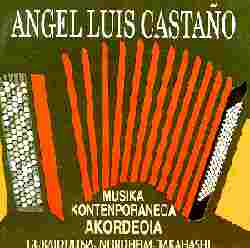The Free-Reed Review
Critiques of Compact Discs, Books and Music Scores
CD Review: Angel Luis Castaño

total time: 52:02
Released in 1992
Review number and date: No. 59, August 1997
label: Elkar (KD-328)
Igarabidea, 88 bis
20009 Donostia
Spain
telephone: 310267
|
Musika Kontenporaneoa Akordeoia
Gubaidulina, Nordheim, Takahashi. . .
Angel Luis Castaño, accordion
Raquel Ruiz, accordion
Carlos Apellaniz, piano
Program:
- Sofia Gubaidulina: De Profundis
- Fermin Gurbindo: Fantasia para Acordeon
- Ole Schmidt: Toccata No. 2, Op. 28
- Arne Nordheim: Flashing
- Ketil Hvoslef: Duo for Accordions
- Yuji Takahashi: Like a Water Buffalo
- Heikki Valpola: "Marilina" for Accordion and Piano
- Preludio
- Energico
- Teneramente
- Misterioso—con brio
|
Review by Henry Doktorski:
Angel Luis Castaño is one of Spain's great concert accordionists. Born in
San Sebastian in 1969, he began playing at the age of five and studied
with Max Bonnay at the Conservatory of Paris and with Mogens Ellegaard at
the Royal Academy of Music in Copenhagen, specializing in contemporary
music for accordion. After winning many competitions in his country,
including the Guipuzcoan Accordion Competition (1987 and 1988), he placed
first in the 1990 Coupe Mondiale competition held in Germany. Today
Castaño is developing a promising career as a concert artist; he also
collaborates with composers to write music specifically for the accordion.
Castaño's first CD is a collection of seven 'classics' for the modern
accordion.
The Russian composer, Sofia Gubaidulina, wrote many works for the
bayan (Russian button accordion). As in many of her works, religious
themes provide the inspiration for De Profundis (1978): it is based on the
psalm of King David which begins "De profundis ad te Domine." The piece
is a contrast between fear and hope represented by dissonant tone clusters
and major chords.
The Spanish composer Fermin Gurbindo wrote, "The form [of Fantasia] is
determined by the title of the work; it lacks tonality, its themes and
principal developments are taken from the first three notes which make two
intervals of the fourth."
Ole Schmidt's Toccata No. 2—commissioned by the Accordion Teachers
Guild in 1963—is a contrapuntal piece with a rhythmic moto perpetua
theme. It was Schmidt's fourth work for the accordion.
Flashing, by the Norwegian composer Arne Nordheim, is a type of
minimalistic work: the opening consists of the single note D, which is
sustained for approximately one minute before other pitches are
introduced.
Duo for Accordions was written by Ketil Hvoslef—another Norse
composer—who subtitled the work "Fantasia on what seven feathers may
lead to . . ." A rhythmic ostinato permeates the work on several levels.
On this piece, Castaño is joined by accordionist Raquel Ruiz.
Like a Water Buffalo, by the Japanese composer Yuhi Takajashi, was
inspired by a poem of the same name by Wendy Poosard about the problems of
Third World peoples. The water buffalo is an animal destined to live its
life as a beast of burden in the Asiatic countryside until it dies; it is
also a symbol of the enslavement of the Japanese people. Parts of Like a
Water Buffalo suggest an Oriental setting by the use of pentatonic scales
and ornaments reminiscent of indigenous Japanese reed instruments.
The Finish composer Heikki Valpola wrote the suite Marilina for
accordion and piano in 1987. It is the most traditional and tonal of all
the pieces on the CD. The final movement—Misterioso—creates
suspense by the repetitive piano ostinato (a perfect fifth) in the low and
dark register of the instrument.
Angel Luis Castaño performs all the pieces on the album with great
attention to details. I cannot find any fault in this CD with one
possible exception: in De Profundis for some strange reason Castano plays
an unusual arpeggio-like figure instead of the register shifts (clearly
marked in the score) on the penultimate page of the piece.
On the other hand, I must compliment him for his creative solution to
the problem of playing the left-hand glissandi during the preceding two
lines of music: Castaño simply switches his hands and plays the top staff
with his left hand and the bottom staff with his right hand.
I recommend this CD for all lovers of contemporary music.
For more information contact:
Angel Luis Castaño
Conservatorio de Música de Segovia
Plaza Conde Cheste, 8
40001 Segovia-SPAIN
E-mail:
